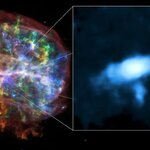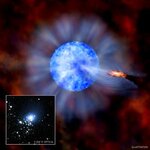Space

XEUS, which stands for X-ray Evolving Universe Spectroscopy, aims to study the fundamental laws of the Universe. With unprecedented sensitivity to the hot, million-degree universe, XEUS will explore key areas of contemporary astrophysics: growth of supermassive black holes, cosmic feedback and galaxy evolution, evolution of large-scale structures, extreme gravity and matter under extreme conditions, the dynamical evolution of cosmic plasmas and cosmic chemistry.
Professor Martin Turner of the University of Leicester is also Chair of the XEUS International Steering committee. He said: “XEUS is…

Fame was fleeting for the 16-solar-mass black hole in the galaxy M33, announced on October 17 as the record holder for the heaviest black hole orbiting a star.
A new black hole, with a mass 24 to 33 times that of our Sun, is more massive than scientists have detected - or expected - for a black hole that formed from a dying star.
The newly discovered object belongs to the category of "stellar-mass" black holes. Formed in the death throes of massive stars, they are smaller than the monster black holes found in galactic cores.
"We weren’t expecting to find a stellar-mass black hole this…

A pair of galaxies, known collectively as Arp 87, is one of hundreds of interacting and merging galaxies known in our nearby Universe. Arp 87 was originally discovered and catalogued by astronomer Halton Arp in the 1970s. Arp’s Atlas of Peculiar Galaxies is a compilation of astronomical photographs using the Palomar 200-inch Hale and the 48-inch Samuel Oschin telescopes.
The resolution in the Hubble image shows exquisite detail and fine structure that was not observable when Arp 87 was first discovered in the 1970’s.
Panning on the interacting galaxies Arp 87. Credit: ESA/Hubble (M.…

Stars always evolve in the universe in large groups, known as clusters. Astronomers distinguish these formations by their age and size. The question of how star clusters are created from interstellar gas clouds and why they then develop in different ways has now been answered by researchers at the Argelander Institute for Astronomy at the University of Bonn with the aid of computer simulations.
The scientists have solved – at least at a theoretical level – one of the oldest astronomical puzzles, namely the question of whether star clusters differ in their internal structure. The findings…

Scientists from the Institute of Physics of Cantabria (IFCA) and the University of Cambridge may have discovered an example of a cosmic defect, a remnant from the Big Bang called a texture. If confirmed, their discovery, reported today in Science, will provide dramatic new insight into how the universe evolved following the Big Bang.
Textures are defects in the structure of the vacuum left over from the hot early universe. Professor Neil Turok of Cambridge’s Department of Applied Mathematics and Theoretical Physics first showed how textures form in the 1990s, highlighting that some would…

New images taken with NASA’s Hubble Space Telescope have revealed the wild side of an elliptical galaxy, nearly two billion light-years away, that previously had been considered mild-mannered.
The Hubble photos show shells of stars around a bright quasar, known as MC2 1635+119, which dominates the center of the galaxy. The presence of the shells is an indication of a titanic clash with another galaxy in the relatively recent past.
The collision, which is funneling gas into the galaxy’s center, is feeding a supermassive black hole. The accretion onto the black hole is the quasar’s energy-…

Stars in dwarf spheroidal galaxies behave in a way that suggests the galaxies are utterly dominated by dark matter, University of Michigan astronomers state.
Astronomy professor Mario Mateo and post-doctoral researcher Matthew Walker measured the velocity of 6,804 stars in seven dwarf satellite galaxies of the Milky Way: Carina, Draco, Fornax, Leo I, Leo II, Sculptor and Sextans. They found that, contrary to what Newton's law of gravity predicts, stars in these galaxies do not move slower the farther they are from their galaxy's core.
"These galaxies show a problem right from the center,"…

Stars die just like people but a spectacular new image shows how complex a star’s afterlife can be. By studying the details of an image made from a long observation by NASA’s Chandra X-ray Observatory, astronomers can better understand how some stars die and disperse elements like oxygen into the next generation of stars and planets.
At a distance of about 20,000 light years, G292.0+1.8 is one of only three supernova remnants in the Milky Way known to contain large amounts of oxygen. The image shows a rapidly expanding, intricately structured, debris field that contains, along with oxygen,…

Envisat satellite image captures fierce easterly desert winds blowing smoke from wildfires in Southern California. Gale-force winds have fed more than a dozen fires from Santa Barbara to the Mexican border since breaking out on Sunday, killing one person and forcing the evacuation of a quarter of a million people.
In the full image below, sand is visible being blown from Mexico’s Baja California Peninsula over the Gulf of California to the east and the Pacific Ocean to the west.
CLICK ABOVE FOR HIGH RESOLUTION.Acquired 22 October 2007 at 17:52 UTC by the MERIS (Medium Resolution Imaging…

Astronomers have located an exceptionally massive black hole in orbit around a huge companion star. This result has intriguing implications for the evolution and ultimate fate of massive stars.
The black hole is part of a binary system in M33, a nearby galaxy about 3 million light years from Earth. By combining data from NASA’s Chandra X-ray Observatory and the Gemini telescope on Mauna Kea, Hawaii, the mass of the black hole, known as M33 X-7, was determined to be 15.7 times that of the Sun. This makes M33 X-7 the most massive stellar black hole known. A stellar black hole is formed from…